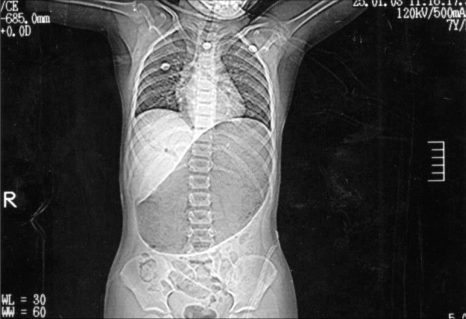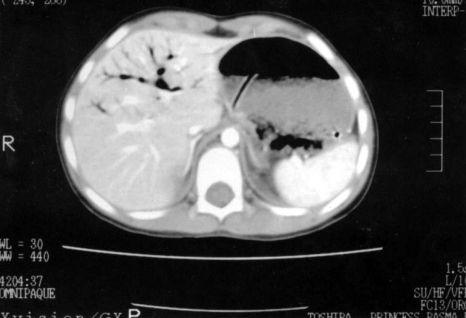Abstract
Gas in the portal veins is rare and in most cases is associated with serious diseases and poor clinical outcome. A case of gas in the hepatic-portal veins with gastric dilatation, as shown by CT-scanning for abdominal trauma, is reported. The condition was clinically benign and resolved spontaneously. An abdominal CT scan documented the findings.
Keywords: Portal venous air; gas, trauma; CT; portal vein
INTRODUCTION
Gas in the portal veins is rare and usually associated with serious diseases and poor clinical outcome.1-3 Reported causes include mesenteric infarction, intestinal obstruction, necrotizing enterocolitis, Crohn's disease, ulcerative colitis, suppurative cholangitis, intra-abdominal abscess, ileus, caustic ingestion, endoscopic retrograde cholangiopancreatography and endoscopic sphincterotomy, gastric dilatation, and seizure.1-12 Herein we present a case of portal venous gas secondary to gastric dilatation. The condition was clinically benign and resolved spontaneously.
CASE REPORT
A 12-year-old female patient was involved in a road-traffic accident. She arrived at the Surgical Casualty Department conscious and anxious , able to move all her limbs, and bleeding from a cut wound on the scalp. Her heart rate and blood pressure were 140/minute and 120/65 mmHg, respectively. The patient could move her neck in all directions. Chest auscultation showed no abnormality. The abdomen was soft, with no tenderness; the bowel sounds were normal; and there was no signs of internal bleeding. The patient was started on Ringer Lactate solution. Complete blood count and kidney function tests were normal. X-rays of the skull, cervical spine, pelvis, long bones, and chest were taken, and only a linear fracture of the right tempero-parietal bone was found. A brain CT scan revealed a right moderate tempero-parietal extra-dural hematoma, which was removed surgically. Six hours later, the patient developed abdominal distension with minimal tenderness in the upper abdomen. A plain X-ray showed a hugely distended stomach (Fig. 1), and an abdominal CT scan showed air in the hepatic-portal veins (Fig. 2), while other abdominal organs appeared normal. When a naso-gastric tube was inserted, the abdomen became soft. The patient was kept nil by mouth and observed. She was started on oral fluid on the third day and was discharged home on the fifth day in good condition. A plain X-ray of her abdomen was taken before discharge and showed no abnormality.
Fig. 1.
Plain X-ray of the abdomen showing extensive gastric dilatation. Portal vein gas is also seen.
Fig. 2.
Cross-section abdominal CT scan. Note the hepatic-portal veins gas, which appears as a branching radiolucency extending to within 2 cm of the liver capsule.
DISCUSSION
Historically, portal venous gas has been associated with serious underlying disease and a high mortality rate.4 It is often associated with intestinal pneumatosis and bowel necrosis.2 Yarze et al. summarized the literature and found that portal venous air has been reported in 3 different clinical settings: (a) related to intra-abdominal sepsis due to various pathological processes (b) in association with inflammatory bowel disease, intestinal obstruction, ulcer disease, and gastroenteritis (c) secondary to "benign" conditions such as after barium enema, colonoscopy, endoscopic biliary sphincterotomy, and seizures.12 These authors suggested that there is no single pathophysiological process that leads to portal venous air in such diverse clinical settings.12
Portal venous gas due to blunt abdominal trauma was initially reported to signal vascular injury and bowel necrosis.13 However, cases of benign portal venous gas seen on CT scans in patients with blunt abdominal trauma have been reported.14,15 The most likely explanation is that a sudden increase in intra-abdominal pressure caused by the impact might force the intra luminal gas into the bowel wall, where it is absorbed into the portal circulation. Once in the portal system, the gas may pass into the hepatic veins via the sinusoids.2,13
Our case seems to indicate an iatrogenic complication of gastric dilatation, and these findings might not occur if the patient's gastrointestinal tract had been properly decompressed (two reasons for decompression are blunt trauma and neurosurgical procedure). We attributed the portal vein gas to gastric dilatation in this patient who was injured in a road-traffic accident and incurred significant head trauma. However, given the complex background, we are not absolutely sure that it is reasonable to draw this conclusion, particularly since there may have been blunt abdominal trauma associated with the original accident. As we mentioned before, portal vein gas can be associated with blunt abdominal trauma. Portal vein gas secondary to gastric dilatation has been reported in previous studies.7,16-19 We speculate that the main cause of gas in the portal vein in our case was gastric dilatation. Portal venous gas might be related to an increase in intraluminal pressure, which forces intraluminal gas through a damaged or undamaged bowel wall, where it is absorbed into the portal circulation. This scenario has been reported in cases of ileus or gastric dilatation, or after blunt abdominal trauma, endoscopy, or barium enema examination.20
As shown in Fig. 2, hepatic-portal venous gas usually appears as a branching radiolucency extending to within 2 cm of the liver capsule.2
The significance of gas in the hepatic-portal veins depends on the underlying pathology; some cases have poor prognoses,3 while others, like our case, have good prognoses.
In conclusion, gas in the portal vein in the liver may occur as a transient incidental finding with gastric dilatation in blunt abdominal trauma. It is difficult to draw a conclusion from a single case report, but we believe that nasogastric drainage for gastric decompression in patients with blunt abdominal trauma might prevent this complication.
References
- 1.Fred HL, Mayhall CG, Harle TS. Hepatic portal venous gas. A review and report on six new cases. Am J Med. 1968;44:557–565. doi: 10.1016/0002-9343(68)90056-9. [DOI] [PubMed] [Google Scholar]
- 2.Liebman PR, Patten MT, Manny J, Benfield JR, Hechtman HB. Hepatic-portal venous gas in adults: etiology, pathophysiology and clinical significance. Ann Surg. 1978;187:281–287. doi: 10.1097/00000658-197803000-00012. [DOI] [PMC free article] [PubMed] [Google Scholar]
- 3.Molik KA, West KW, Rescorla FJ, Scherer LR, Engum SA, Grosfeld JL. Portal venous air: the poor prognosis persists. J Pediatr Surg. 2001;36:1143–1145. doi: 10.1053/jpsu.2001.25732. [DOI] [PubMed] [Google Scholar]
- 4.Faberman RS, Mayo-Smith WW. Outcome of 17 patients with portal venous gas detected by CT. AJR Am J Roentgenol. 1997;169:1535–1538. doi: 10.2214/ajr.169.6.9393159. [DOI] [PubMed] [Google Scholar]
- 5.Gosink BB. Intrahepatic gas: differential diagnosis. AJR Am J Roentgenol. 1981;137:763–767. doi: 10.2214/ajr.137.4.763. [DOI] [PubMed] [Google Scholar]
- 6.Quirke TE. Hepatic-portal venous gas associated with ileus. Am Surg. 1995;61:1084–1086. [PubMed] [Google Scholar]
- 7.Benson MD. Adult survival with intrahepatic portal venous gas secondary to acute gastric dilatation, with a review of portal venous gas. Clin Radiol. 1985;36:441–443. doi: 10.1016/s0009-9260(85)80339-1. [DOI] [PubMed] [Google Scholar]
- 8.Kirsch M, Bozdech J, Gardner DA. Hepatic portal venous gas: an unusual presentation of Crohn's disease. Am J Gastroenterol. 1990;85:1521–1523. [PubMed] [Google Scholar]
- 9.Tan EC, Jager GJ, Bleeker WA, Van Goor H. Portal venous air in an adult patient with obstructive small bowel volvulus. Dig Surg. 2002;19:400–402. doi: 10.1159/000065819. [DOI] [PubMed] [Google Scholar]
- 10.Herman JB, Levine MS, Long WB. Portal venous gas as a complication of ERCP and endoscopic sphincterotomy. Am J Gastroenterol. 1995;90:828–829. [PubMed] [Google Scholar]
- 11.Chen KW, Shin JS, Chi CH, Cheng L. Seizure: a rare and transient cause of portal venous gas. Am J Gastroenterol. 1997;92:351–352. [PubMed] [Google Scholar]
- 12.Yarze JC, Dimick RN, DeCunzo LP. Massive portal venous air in a 24-year-old patient. Am J Gastroenterol. 1999;94:3657–3658. doi: 10.1111/j.1572-0241.1999.01631.x. [DOI] [PubMed] [Google Scholar]
- 13.Friedman D, Flancbaum L, Ritter E, Trooskin SZ. Hepatic portal venous gas identified by computed tomography in a patient with blunt abdominal trauma: a case report. J Trauma. 1991;31:290–292. [PubMed] [Google Scholar]
- 14.Vauthey JN, Matthews CC. Portal vein air embolization after blunt abdominal trauma. Am Surg. 1988;54:586–588. [PubMed] [Google Scholar]
- 15.Dill-Macky MJ. Benign hepatic portal venous gas following blunt abdominal trauma. Australas Radiol. 1997;41:166–168. doi: 10.1111/j.1440-1673.1997.tb00705.x. [DOI] [PubMed] [Google Scholar]
- 16.Parada González P, Fernández Rodríguez E, Nuño Váquez-Garza JM, González Fernández S, Casal Núñez JE. Portal venous gas secondary to acute gastric dilatation. Rev Esp Enferm Dig. 2004;96:227–228. doi: 10.4321/s1130-01082004000300011. [DOI] [PubMed] [Google Scholar]
- 17.Celoria G, Nardini A, Falco E, Montrucchio E, Pera M, Graziano M. Intraportal air secondary to gastric dilatation. A clinical case. Minerva Chir. 1994;49:371–373. [PubMed] [Google Scholar]
- 18.Lamberto S, Vinci S, Salamone I, Racchiusa S. Intrahepatic portal vein gas. Good prognosis in patients with gastric dilatation. Case report. Radiol Med (Torino) 2001;101:508–510. [PubMed] [Google Scholar]
- 19.Radin DR, Rosen RS, Halls JM. Acute gastric dilatation: a rare cause of portal venous gas. AJR Am J Roentgenol. 1987;148:279–280. doi: 10.2214/ajr.148.2.279. [DOI] [PubMed] [Google Scholar]
- 20.Chevallier P, Peten E, Souci J, Chau Y, Padovani B, Bruneton JN. Detection of portal venous gas on sonography, but not on CT. Eur Radiol. 2002;12:1175–1178. doi: 10.1007/s00330-001-1144-x. [DOI] [PubMed] [Google Scholar]




